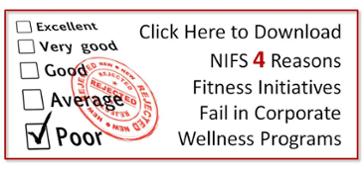
But don’t confuse our lack of skills for ROI analysis with a general lack of drive for data. In fact, it’s quite the opposite. Ask my staff; they can just about recite from memory my key points on the importance of evaluating the programs they’re running and the services they’re providing to determine impact.
Here’s the thing about evaluation: truth #1, truth #2, and truth #3 matter a lot less when you aren’t taking the time to be strategic about what you’re doing with exercise programming for your employees. If you’re just going to slap spaghetti against the wall to see what sticks, why bother? There are too many tasks competing for your precious time to not implement your corporate wellness initiatives wisely.
Truth #4: Fitness initiatives fail as part of a corporate wellness strategy because evaluation of the programs isn’t incorporated into program design.
Raise your hand if any of these points sounds like something you want to do for your corporate wellness program:
- Make the case for more money, more staff, more support, and more respect.
- Spend time on programs that are really making an impact.
- Drill down to the tougher issues in corporate wellness, like sustained participation.
- Observe and act on trends over time in participation, completion rates, and overall impact for similarly situated initiatives.
With a comprehensive evaluation strategy in place for your corporate wellness programs, you can accomplish most, if not all, of those things. I know because that’s exactly what we do for our corporate fitness management clients.
A Breakthrough
Several years ago, I spent a lot of time wracking my brain trying to figure out how we could jump into the ROI game. But I kept getting stalled at our lack of access to all the data, the variables I couldn’t account for, and my extremely limited knowledge of statistics. It seemed like there must be some door I needed to open that would reveal the secret formula I needed to get to the next steps. But I couldn’t find that door for my life.
Then I heard Ron Goetzel speak at the American Journal of Health Promotion conference. During his seminar he pretty much just came out and said it. I, me, myself, could not calculate ROI alone. I would need a team, and some (a lot of) money and it would be much broader than our small impact in a corporate fitness program.
After I got over a mixture of disappointment (I had been so sure I could figure it out!) and relief, I got to thinking about what I could do that focused on data and ultimately evaluated effectiveness of our programs and services. In the end, we built an evaluation framework that made sense for us and allowed us to (1) prove our worth for our clients who had invited us to manage their fitness centers as part of their wellness program, and (2) communicate better information to our members who were counting on us to help them improve their health.
Building the Case for Corporate Wellness
So let me spare you my investigational roller coaster because what was true for me is likely also true for you: you probably don’t have what you need to really calculate ROI from your corporate wellness program. But let’s face it, even the most generous of CEOs won’t throw cash at initiatives indefinitely. You will need to build a case for the effectiveness of your efforts early on. When you can begin drafting your initiatives with an end in mind where you set out SMART goals and then evaluate your progress against those goals, you have what you need to start building your case.
In our experience, though, it’s not just about setting goals and then looking back at the data to see if you achieved them. That’s only part of the evaluation framework. The other part is looking at impact, and impact can be measured when you look at your communication strategy, how effectively the program is run, and what participation rates and completion rates are.
When you start to piece out those specific impact-related elements, you can get a sense of opportunities for improvement that lie within your initiatives. For example, maybe you learned through a post-program survey that your communication strategy wasn’t focused on the best avenue to reach your designated population. Perhaps that group would rather receive a postcard invitation than an email. And poof—just like that you have some actionable data on which you can start improving the next offering. But if you didn’t plan out the initiative with the concept of offering a post-program survey that would assess program communication, you have no data on which to act.
I’ve said it before and it bears repeating here: We’re not experts at all things corporate wellness. But I strongly submit that if this evaluation strategy works for our corporate fitness initiatives, it’ll work for other areas of your wellness programming, too. And if you want to read more about the “how-to” of program evaluation, check out our blog: 4 Keys to Getting Wellness Program Data You Can Actually Use.
Looking for one resource that contains all four of these truths about why corporate fitness initiatives fail in corporate wellness? Download our eBook for the full series.


 In this blog series, we’re focusing on why fitness fails as part of a corporate wellness strategy. The first two truths looked at how
In this blog series, we’re focusing on why fitness fails as part of a corporate wellness strategy. The first two truths looked at how 
 Summer is the perfect time to take on a big fitness challenge! How about trying the famous
Summer is the perfect time to take on a big fitness challenge! How about trying the famous 
 Truth #1: Fitness initiatives fail as part of a corporate wellness strategy because of a lack of programming creativity.
Truth #1: Fitness initiatives fail as part of a corporate wellness strategy because of a lack of programming creativity. 
 It's the Fourth of July and many of you are probably gearing up to enjoy the outdoors at family gatherings and pool parties. Start your day off right with a workout. During the summer months, exercise is seen as a daunting task by many, however it can be enjoyable if you follow these suggestions for exercising in warm weather.
It's the Fourth of July and many of you are probably gearing up to enjoy the outdoors at family gatherings and pool parties. Start your day off right with a workout. During the summer months, exercise is seen as a daunting task by many, however it can be enjoyable if you follow these suggestions for exercising in warm weather.  Are you one of those people that only use the elliptical machine when told to lie off of exercise due to a lower body injury? Even though most studies have found that the treadmill may burn a few more calories, it’s still important to mix up your workouts. If you are a runner I’m sure you have heard about the importance of cross training your muscles to prevent injuries. The elliptical is a good way to cross train and can be just as challenging!
Are you one of those people that only use the elliptical machine when told to lie off of exercise due to a lower body injury? Even though most studies have found that the treadmill may burn a few more calories, it’s still important to mix up your workouts. If you are a runner I’m sure you have heard about the importance of cross training your muscles to prevent injuries. The elliptical is a good way to cross train and can be just as challenging! Cardiovascular exercise…..people either love it or hate it! I’m sure by now you’ve heard that cardio alone is not the answer to reaching your fitness goals. It is important to add a strength and flexibility component too. Although, cardio and physical activity in general have many health benefits, but they have even more when you “mix it up”!
Cardiovascular exercise…..people either love it or hate it! I’m sure by now you’ve heard that cardio alone is not the answer to reaching your fitness goals. It is important to add a strength and flexibility component too. Although, cardio and physical activity in general have many health benefits, but they have even more when you “mix it up”! Have you heard this
Have you heard this  I woke up one morning and my obliques were really sore and tender to the touch. I couldn’t figure it out because I hadn’t taught or taken a core class the day before at my corporate wellness site. Then it hit me that the only thing different I had done was sprints. I hadn’t done sprints since track practice, which was a long time ago, but I had no idea how much I use my core! I loved the feeling of my obliques being that sore, so I decided to start incorporating more sprints into my workouts.
I woke up one morning and my obliques were really sore and tender to the touch. I couldn’t figure it out because I hadn’t taught or taken a core class the day before at my corporate wellness site. Then it hit me that the only thing different I had done was sprints. I hadn’t done sprints since track practice, which was a long time ago, but I had no idea how much I use my core! I loved the feeling of my obliques being that sore, so I decided to start incorporating more sprints into my workouts.